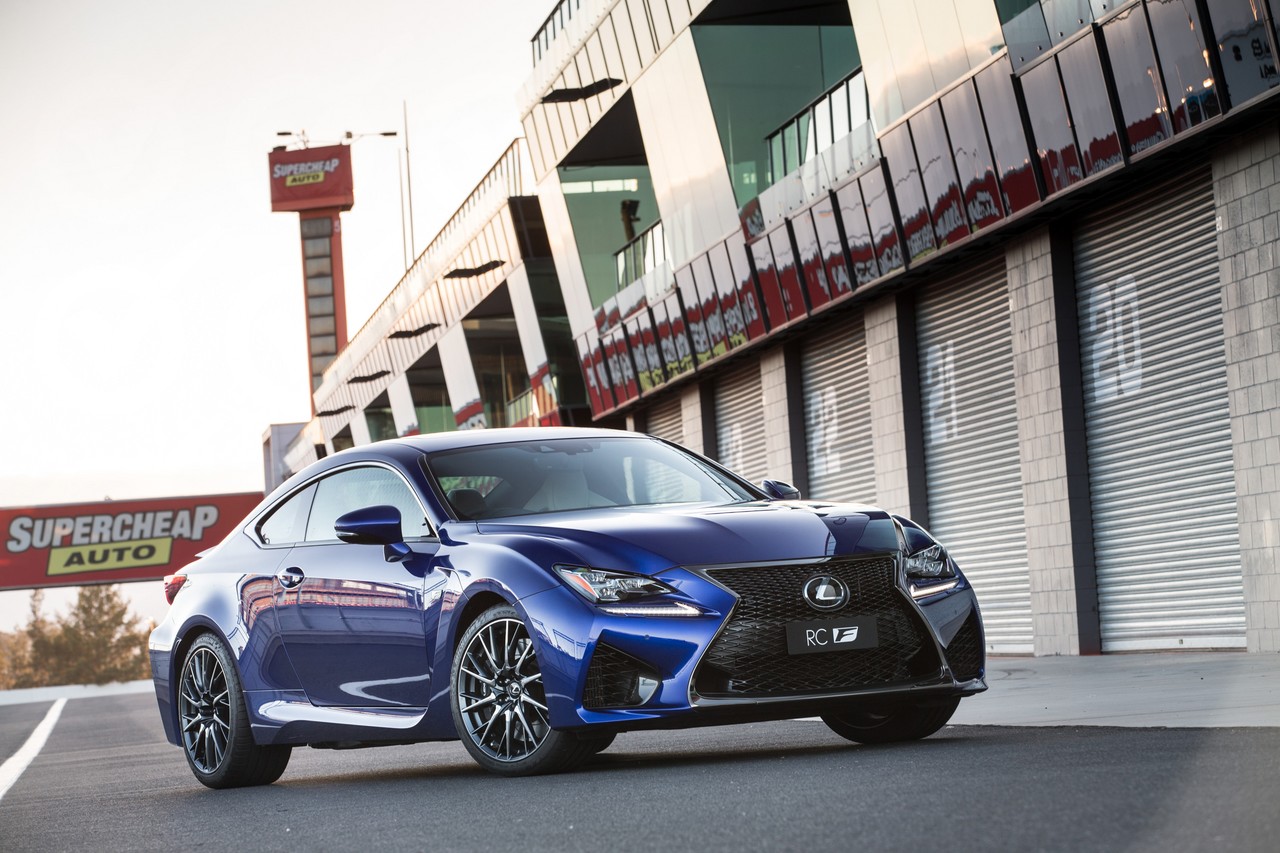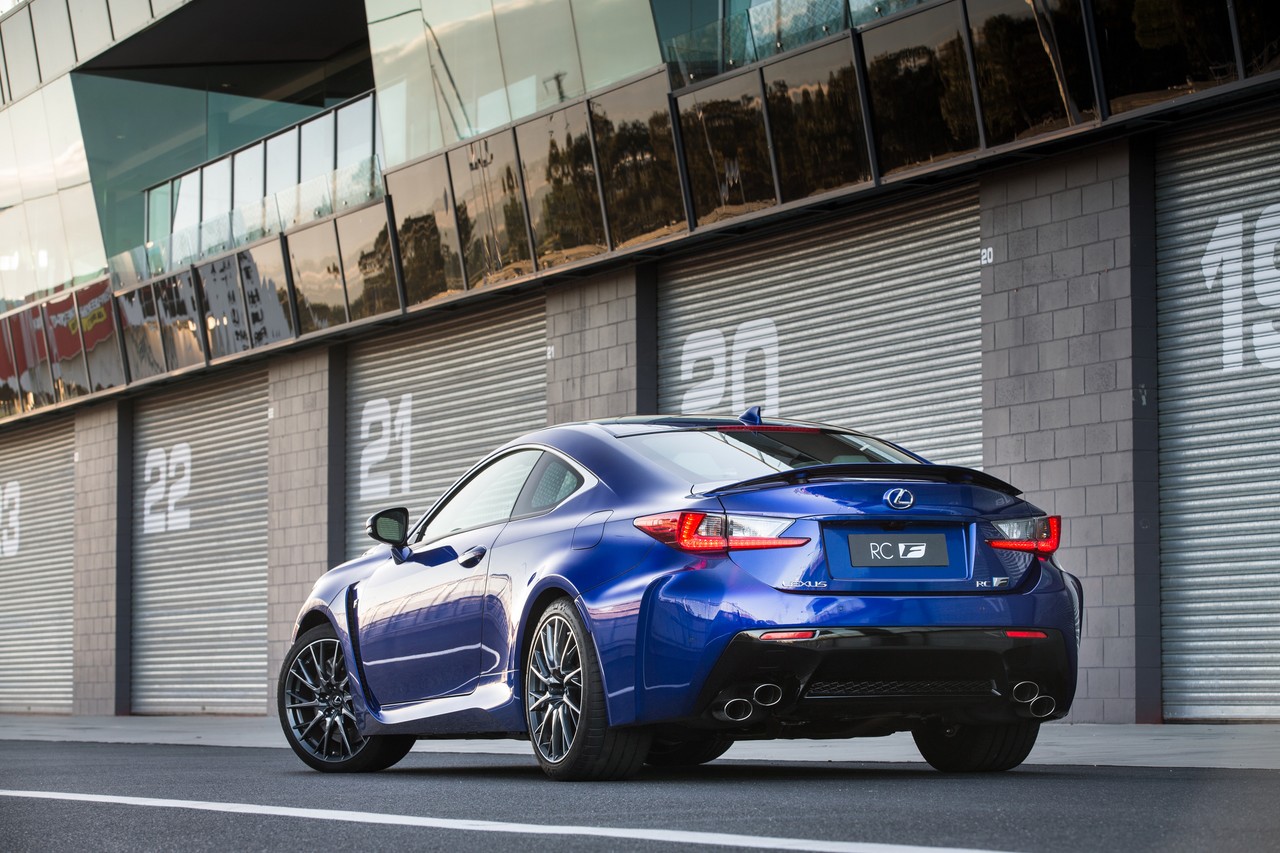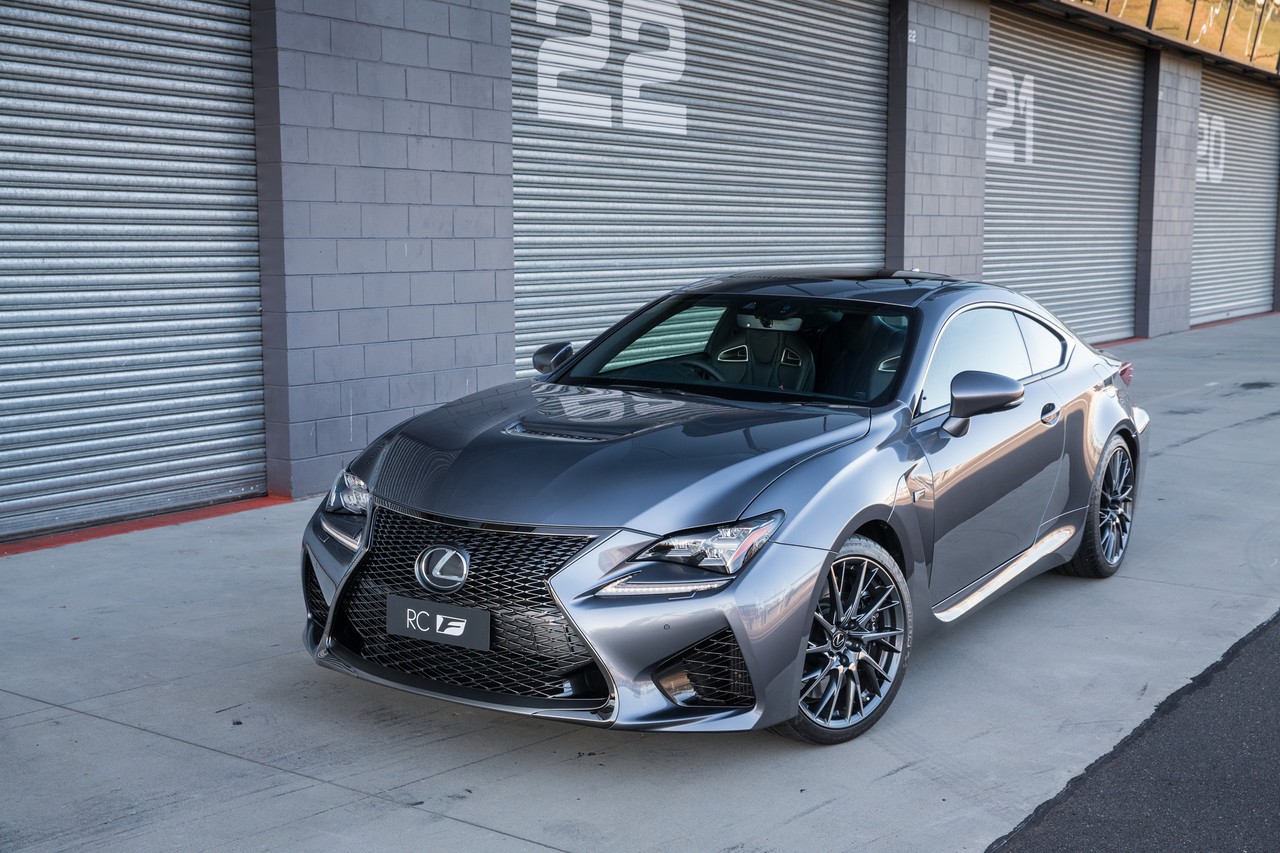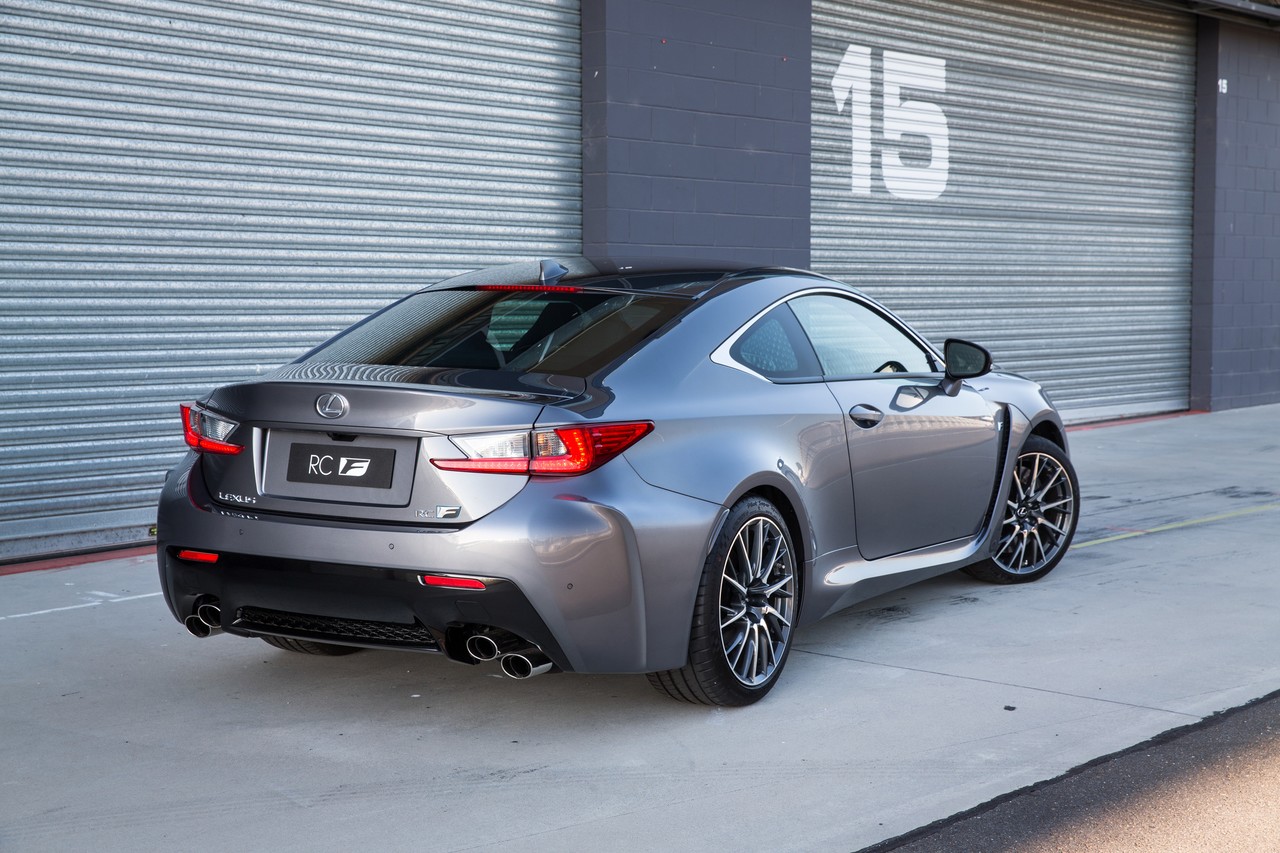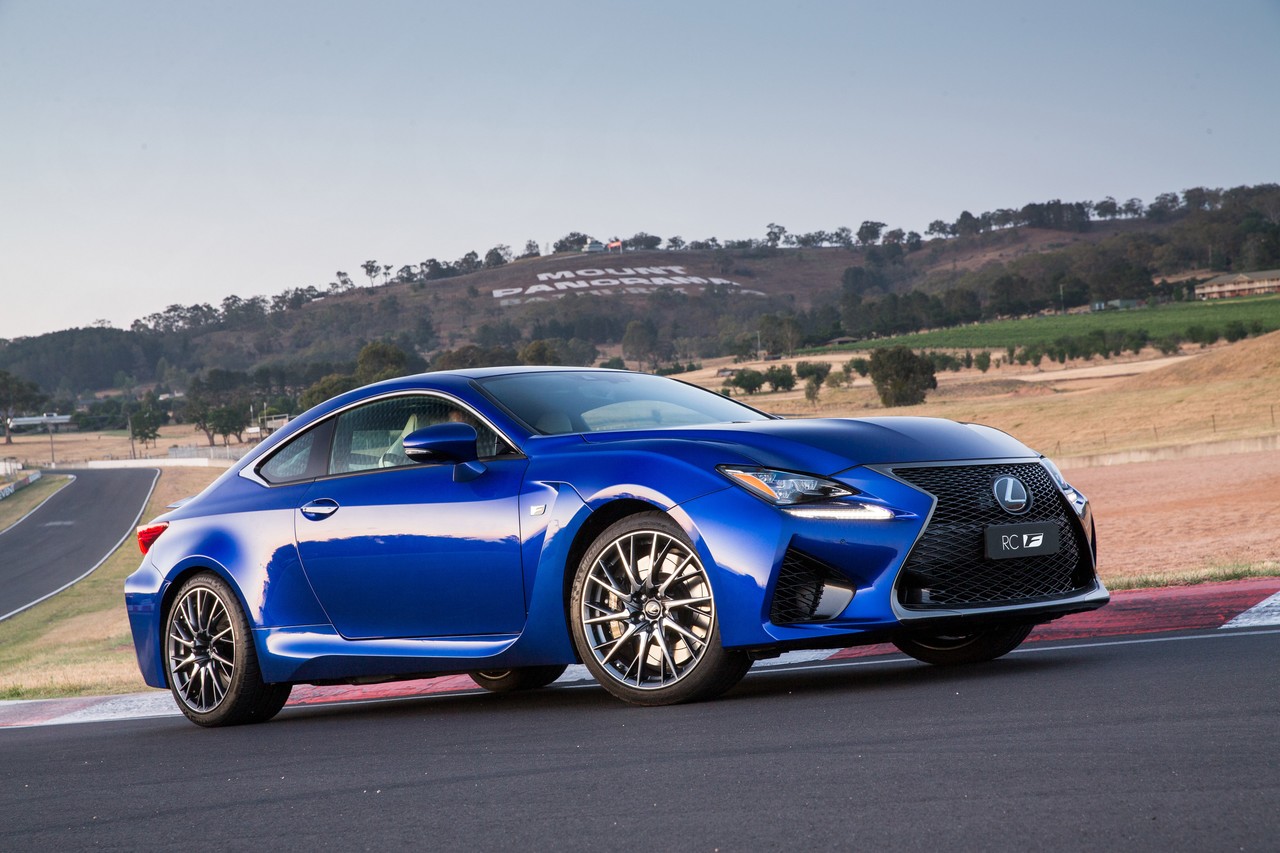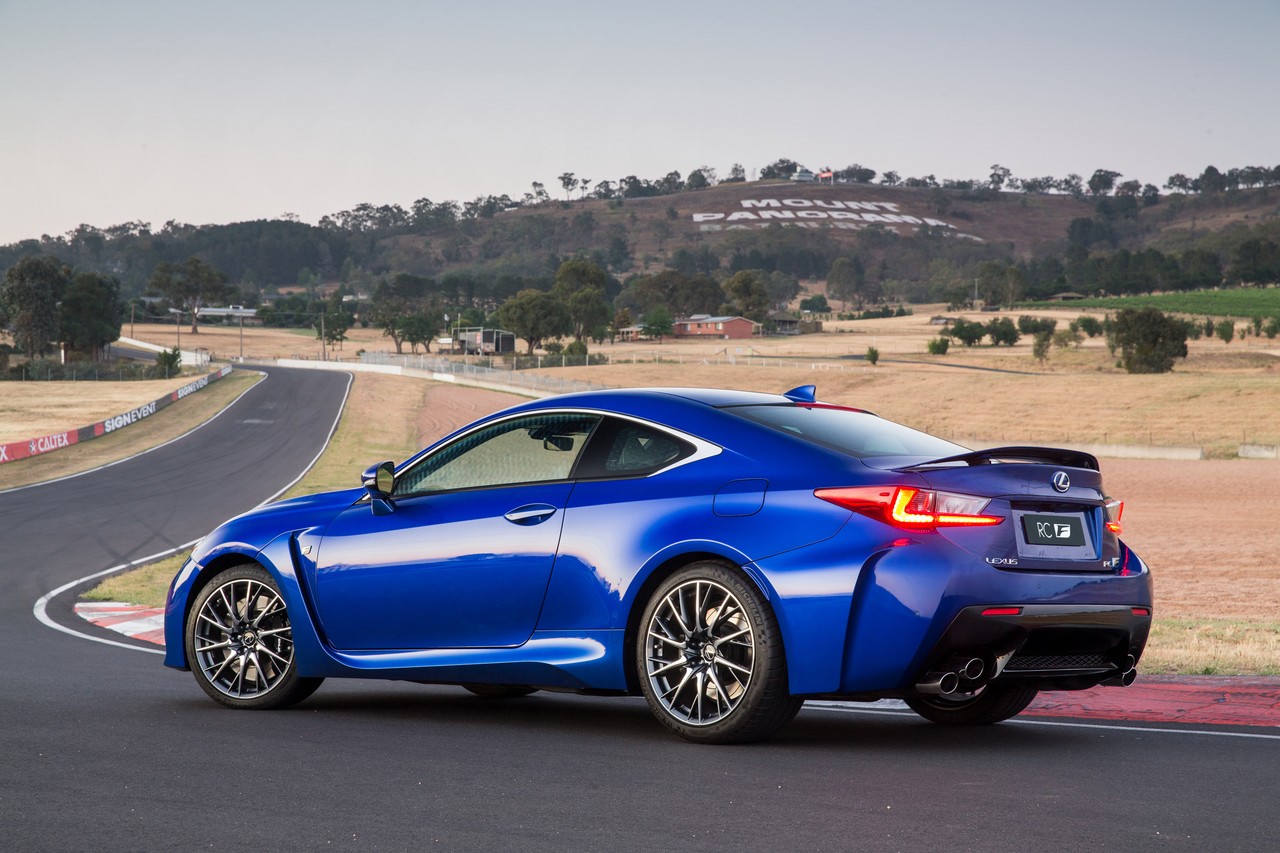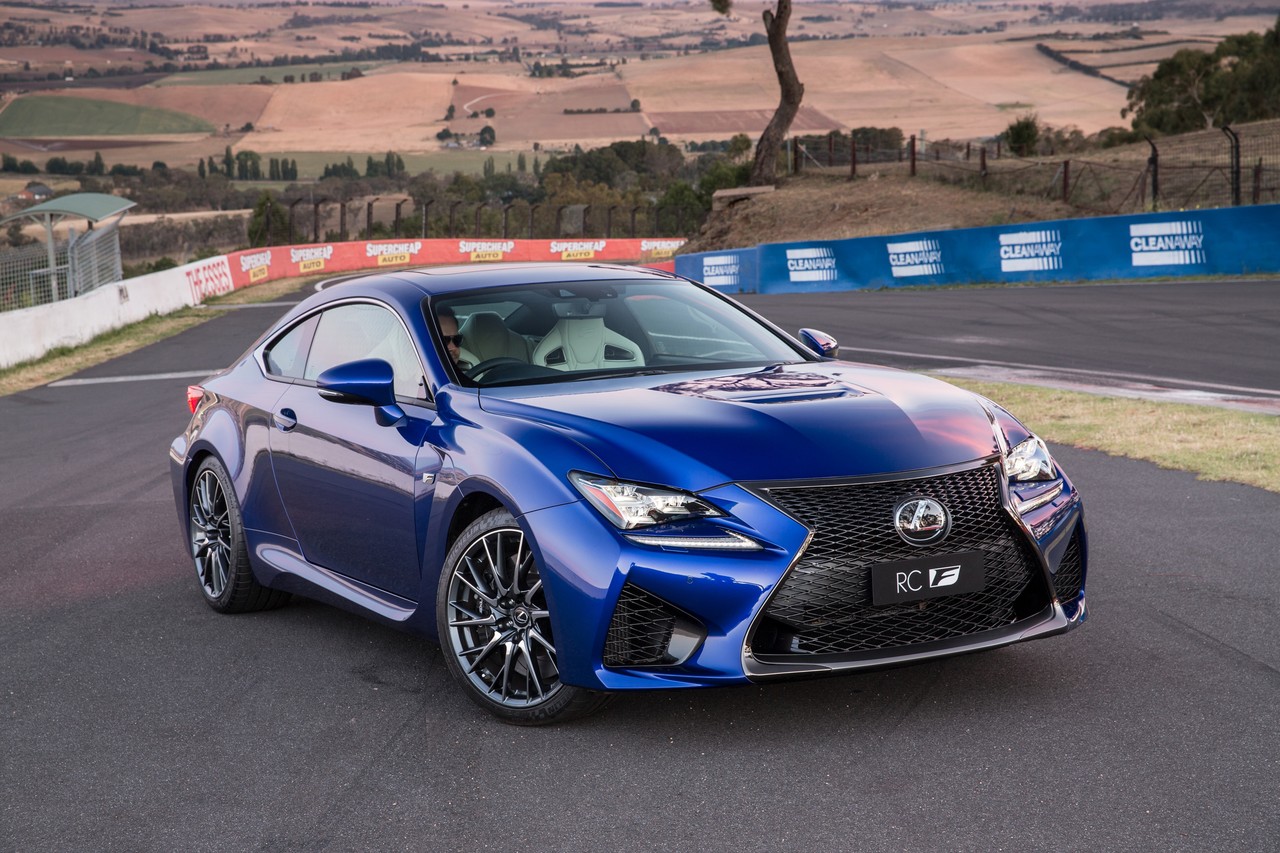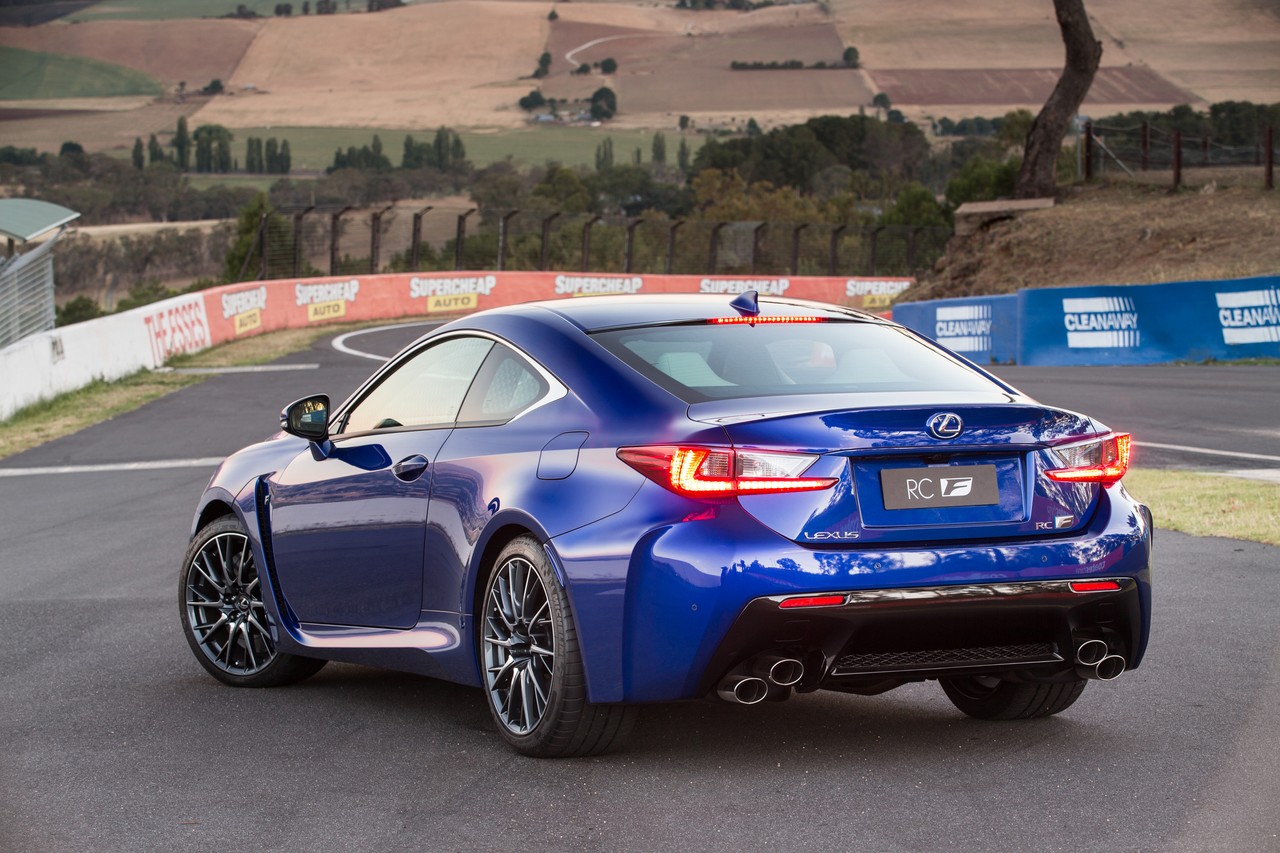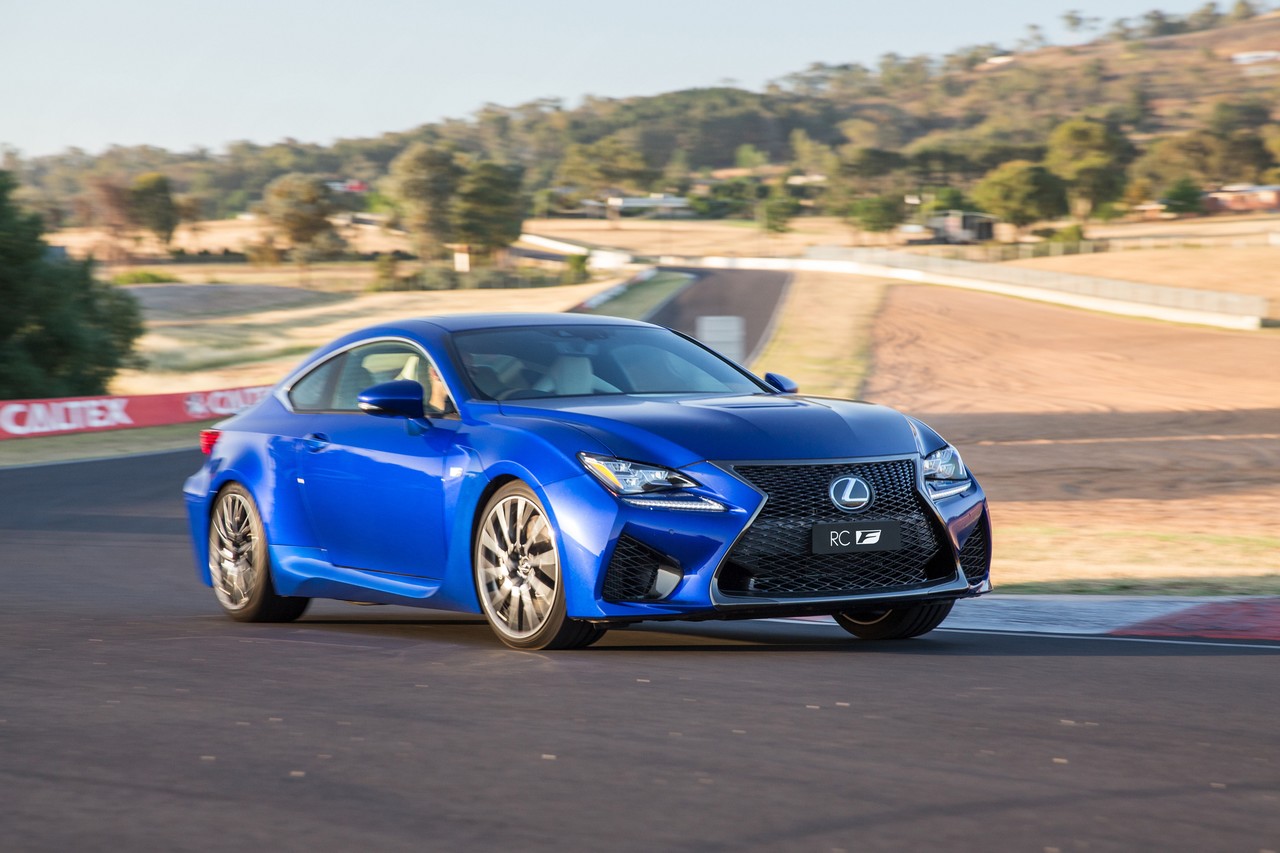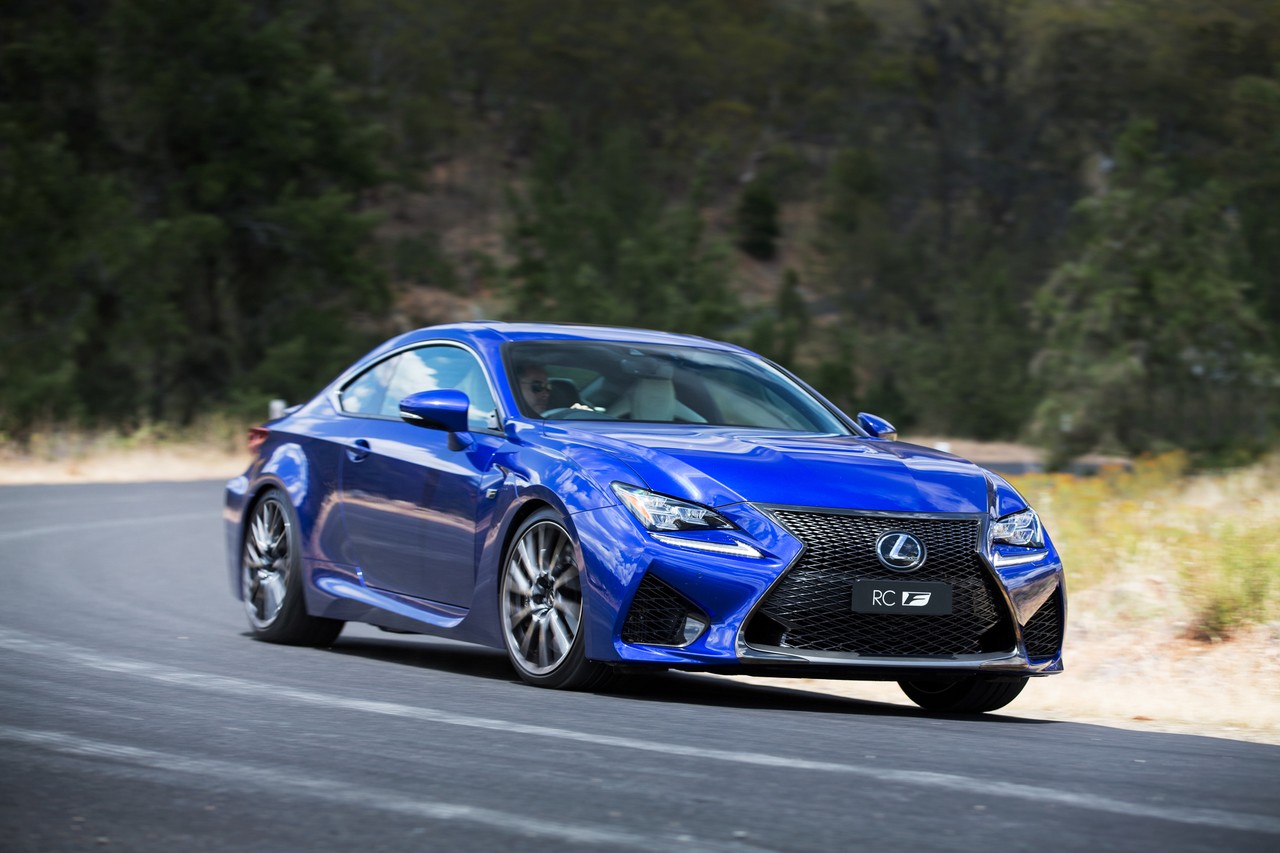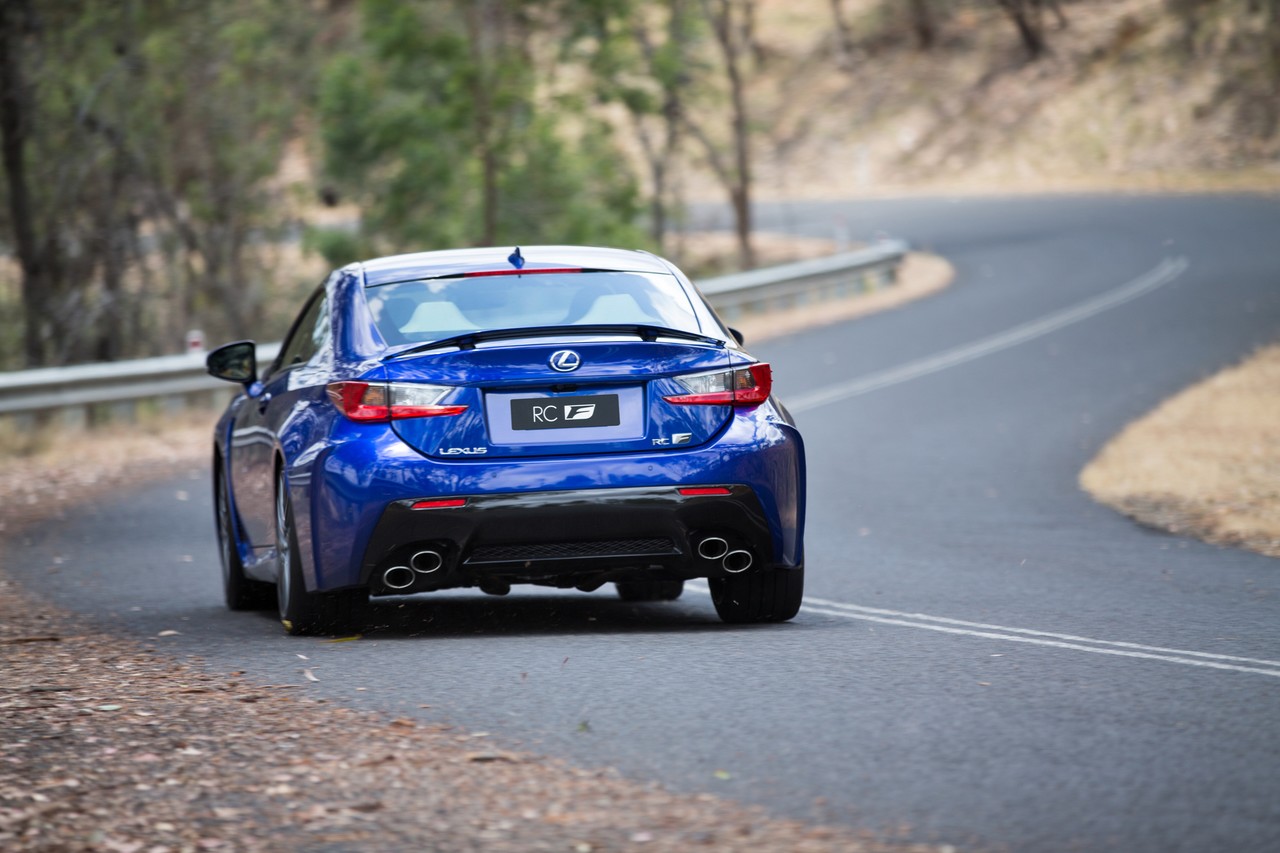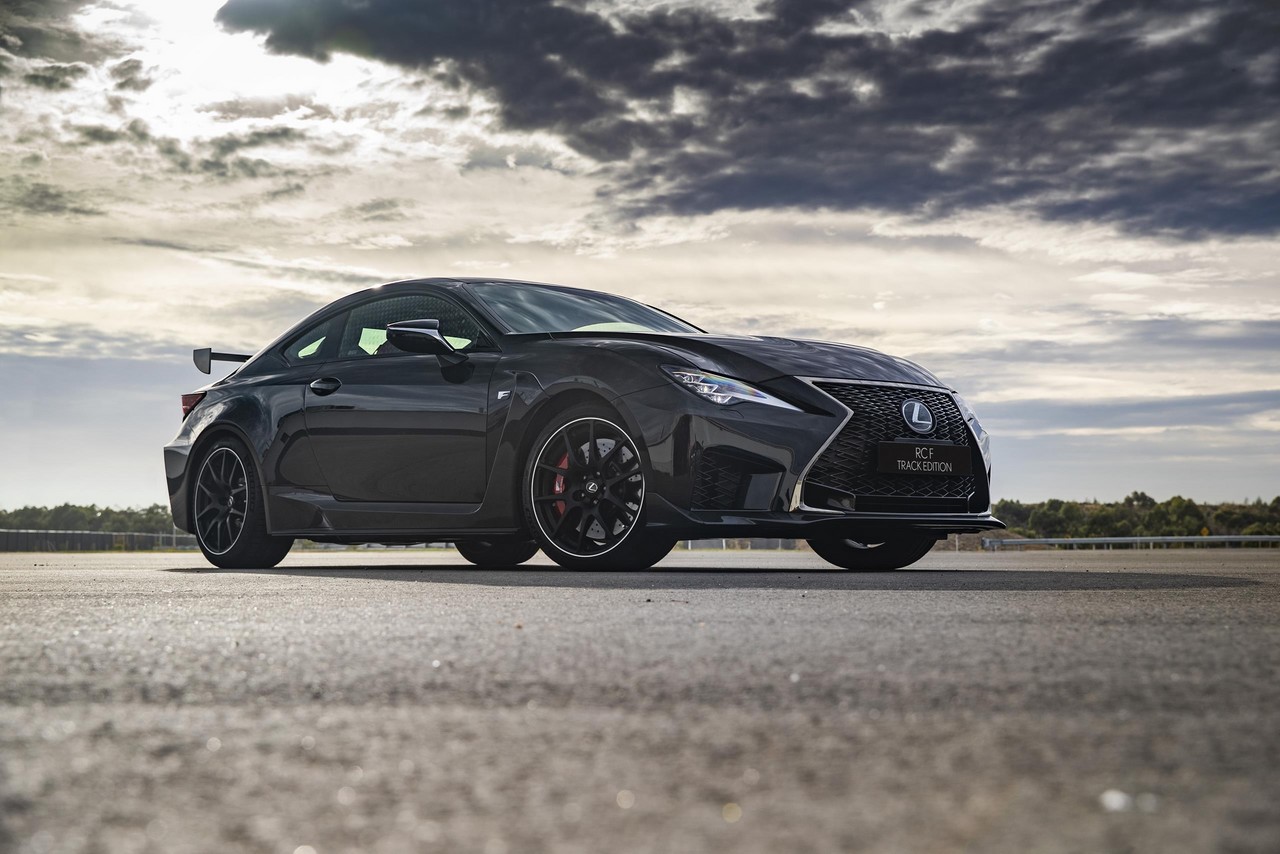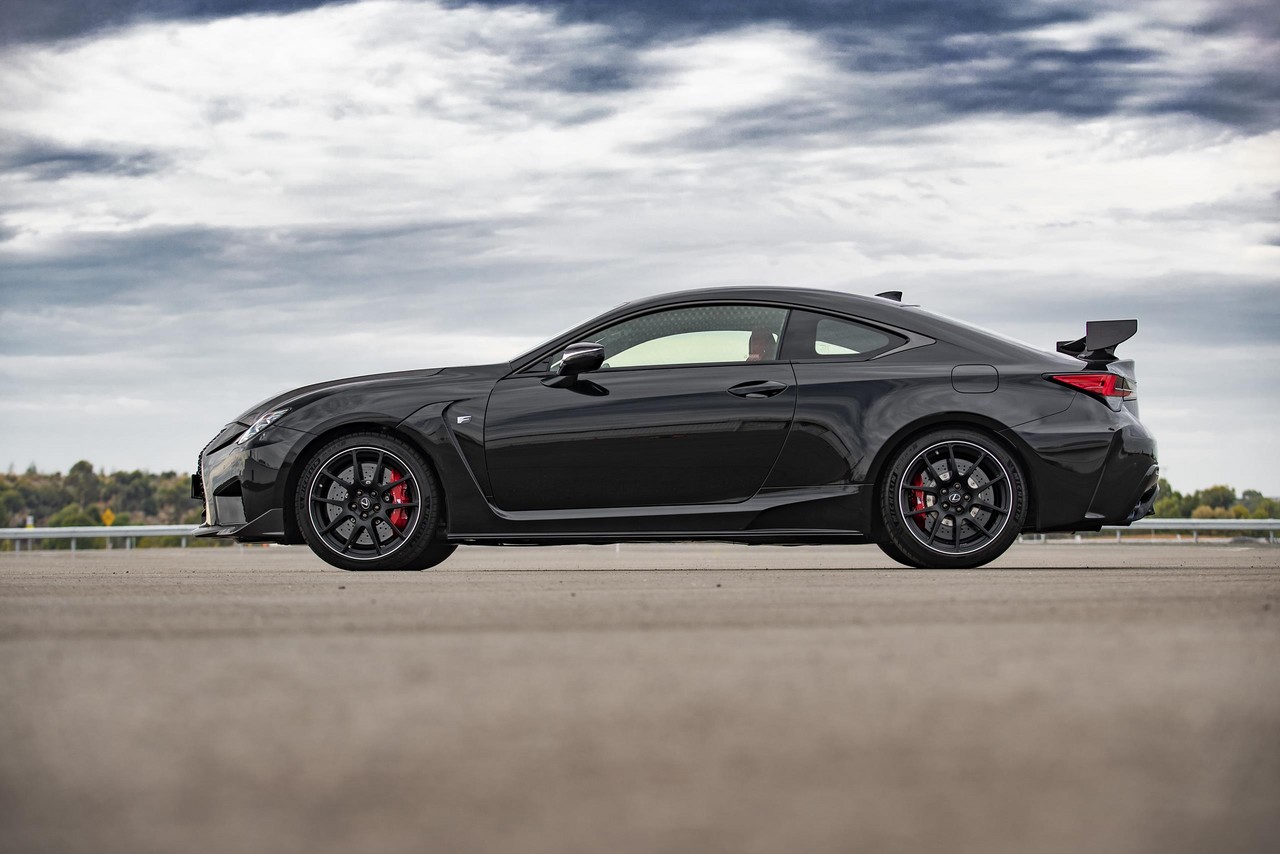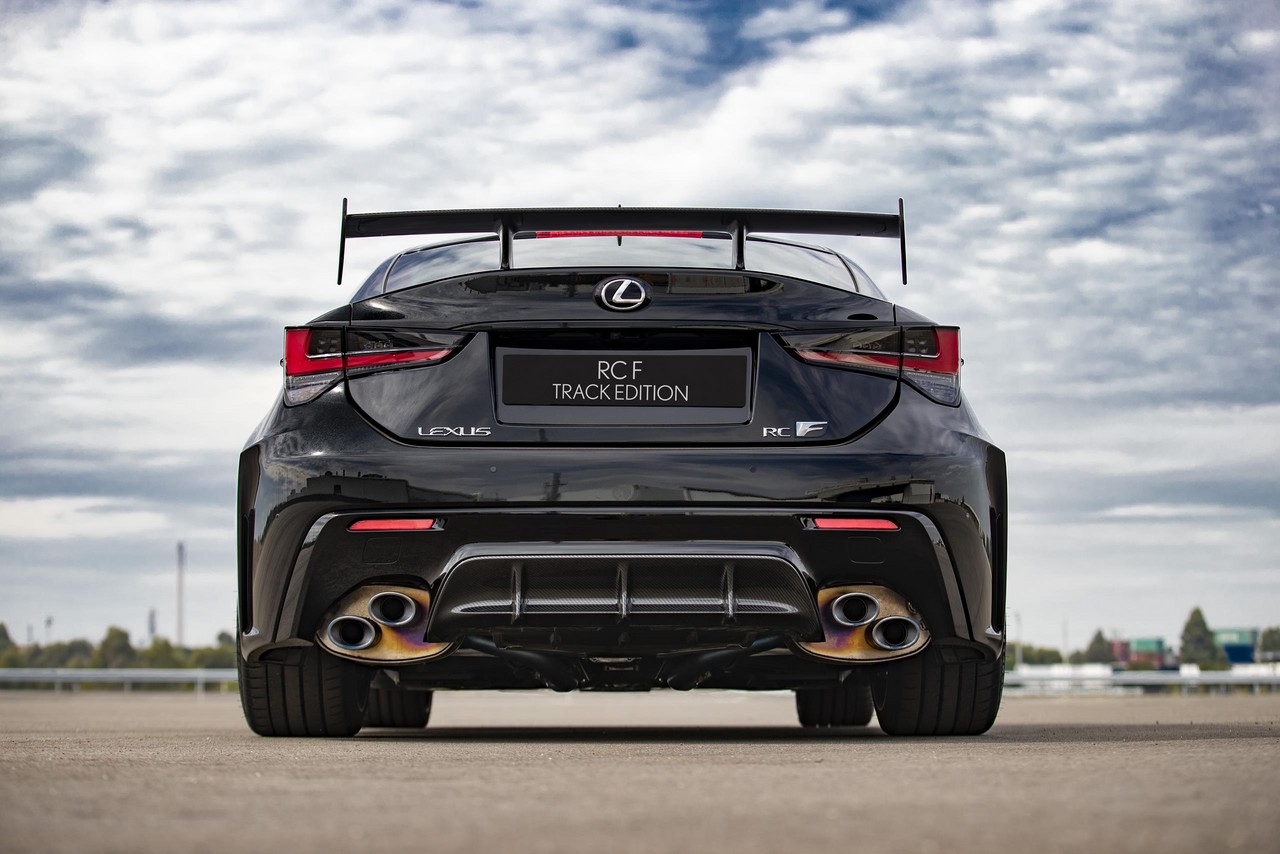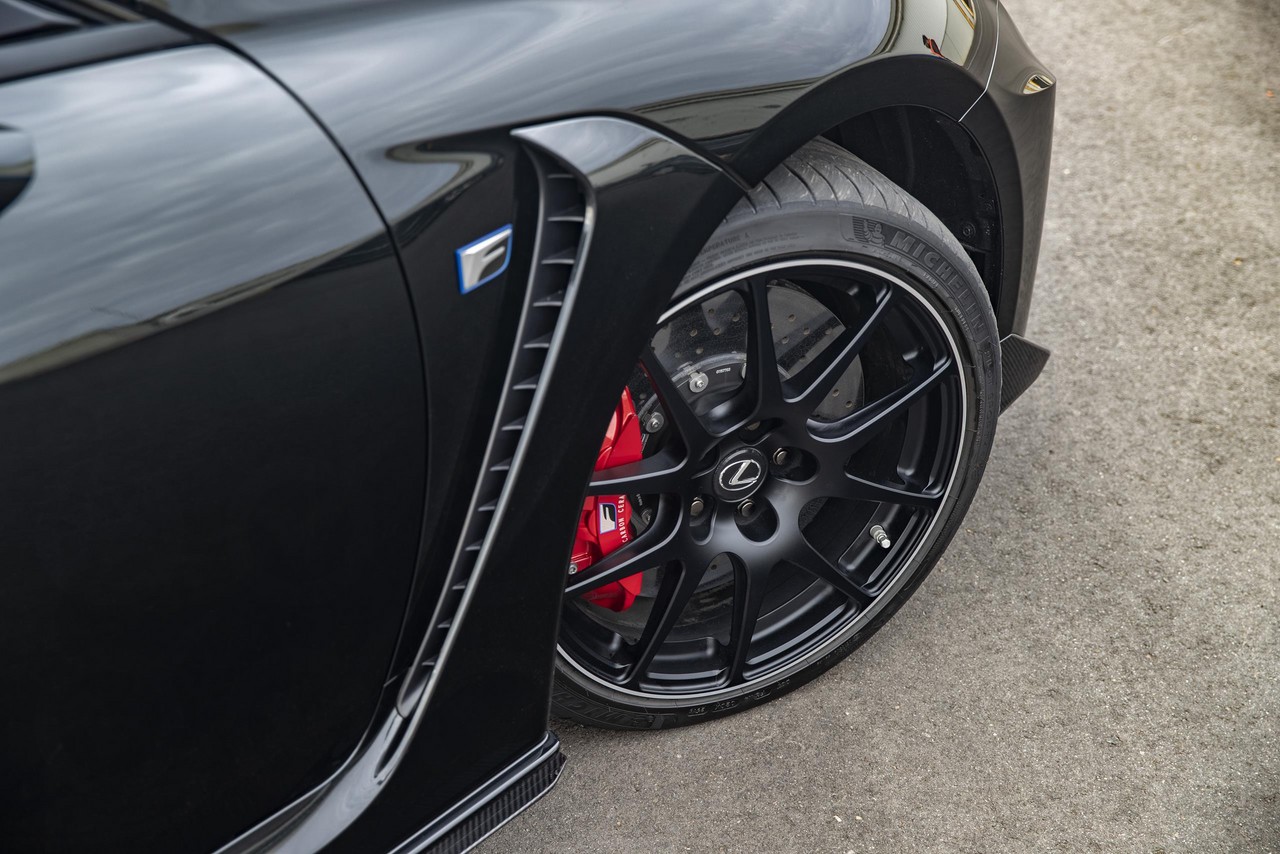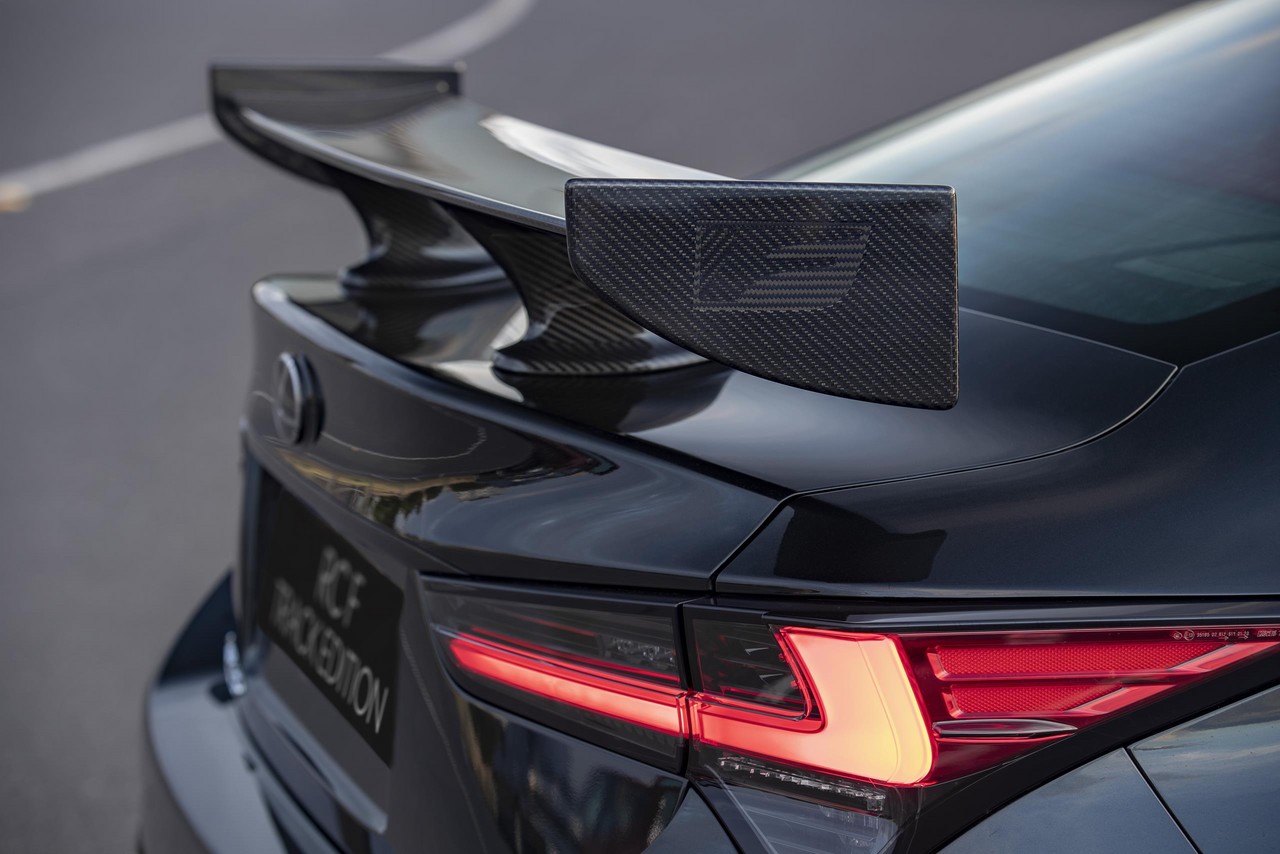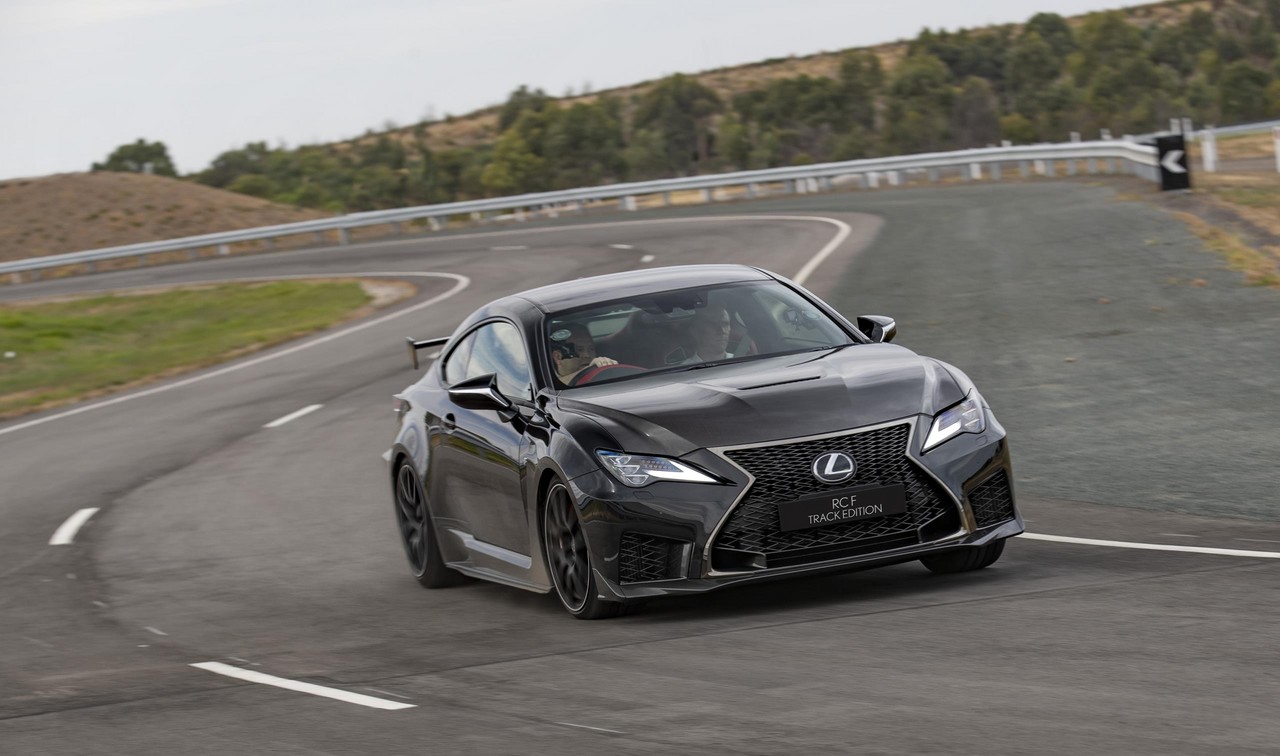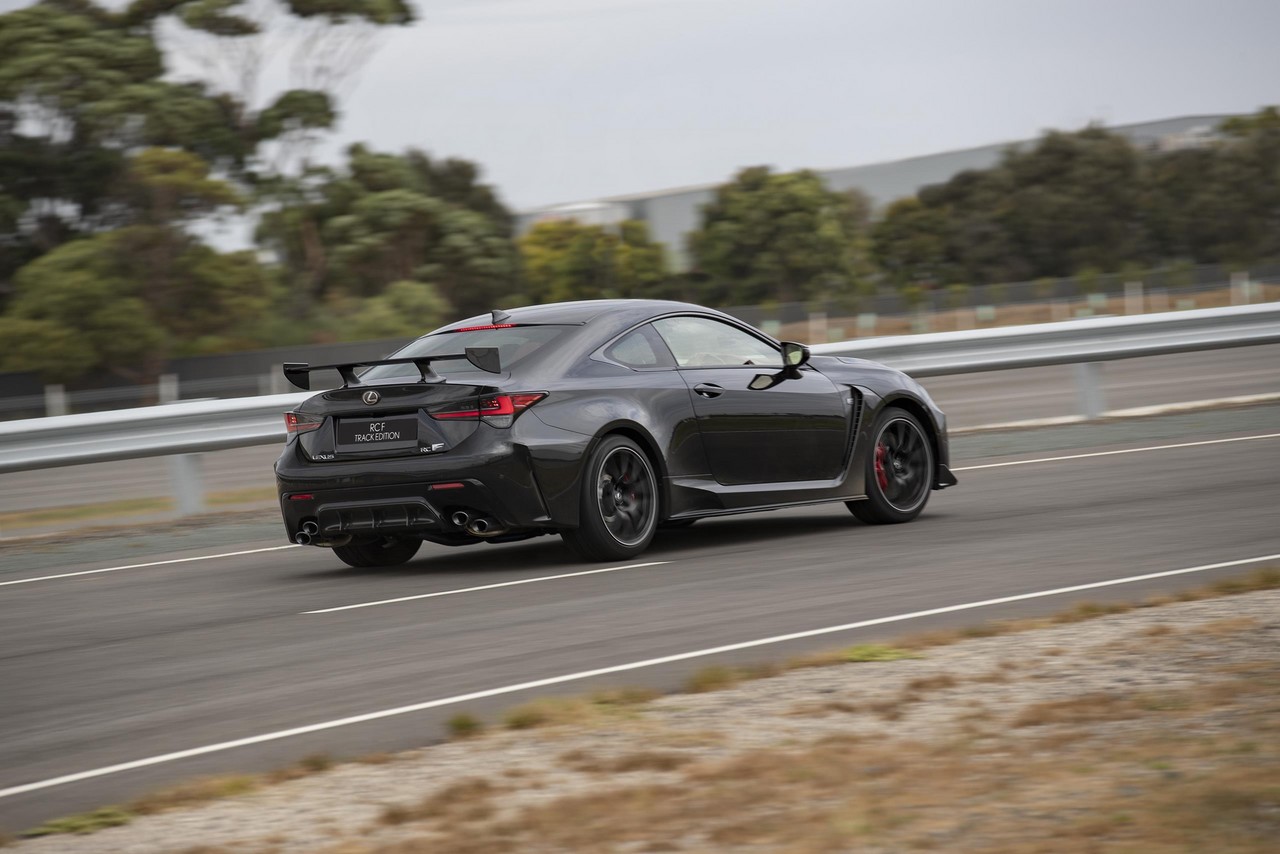
- Refined and free-revving 5.0-litre 2UR-GSE V8 engine
- Balanced chassis makes for impressive dynamics
- Direct and precise steering…
- … lacks feedback
- Suspension lacks compliance
- Weight blunts agility
Review: Lexus XC10.I RC F (2014-19)
Overview
Released in Australia in November 2014, the Lexus XC10 RC F was a high-performance, rear-wheel drive coupe. Manufactured in Tahara, Japan, the Lexus RC F was powered by a 5.0-litre V8 petrol engine that was mated to an eight-speed automatic transmission.
2UR-GSE V8 engine
Based on the XE20 IS F ‘s 5.0-litre 2UR-FSE V8 engine , the 2UR-GSE engine had a die-cast aluminium block, aluminium cylinder heads, forged connecting rods, double overhead camshafts per cylinder bank, VVT-iE camshaft timing (i.e. an electrically-operated actuator controlled intake camshaft timing, whereas exhaust camshaft timing used a conventional hydraulic actuator), magnesium cylinder covers, four valves per cylinder (with titanium inlet valves), variable intake and exhaust valve timing (‘Dual VVT-i’), a two-stage intake system and a compression ratio of 12.3:1. Maximum engine speed for the 2UR-GSE was 7300 rpm.
The 2UR-GSE engine featured a twin injection fuel system which combined direct injection with traditional port injection (the latter for more precise air/fuel mixing under low and medium load conditions). Furthermore, the 2UR-GSE engine operated with an Atkinson cycle at cruising speeds for improved fuel economy and an Otto cycle at higher speeds for greater power.
The Lexus RC F could accelerate from rest to 100 km/h in 4.5 seconds and had an electronically limited top speed of 270 km/h. Furthermore, the 2UR-GSE engine required 98 RON premium unleaded petrol (PULP).
AA80E transmission
The Lexus RC F had an eight-speed ‘Sports Direct Shift’ (SPDS) automatic transmission which could provide electronically-controlled sequential shifts via the gear lever or steering wheel gearshift paddles in ‘M’ mode. In M mode, upshifts could be completed in 0.3 seconds and downshifts in 0.2 seconds, with the throttle blipping control matching engine speed to the gear.
| Motor | Trans. | Peak power | Peak torque | |
|---|---|---|---|---|
| RC F | 5.0-litre petrol V8 (2UR-GSE) | 8sp auto | 351 kW at 7100 rpm | 530 Nm at 4800-5600 rpm |
Torque Vectoring Differential
According to Lexus, the Lexus RC F was the first front-engined, rear-wheel drive vehicle to be fitted with a Torque Vectoring Differential (TVD). The TVD could control the distribution of power between the rear wheels via electronically-controlled actuator motors and multi-plate clutches. Furthermore, the TVD had three selectable drive modes:
- Standard: for a balance of performance and stability;
- Slalom: for emphasis on nimble steering response; and,
- Track: for consistent, stable behaviour especially under acceleration.
Dimensions
Like the four-door Lexus XE30 IS , the Lexus RC F was underpinned by Toyota’s ‘New N’ platform. Compared to the standard Lexus RC , the RC F was be 10 mm longer (at 4705 mm), 5 mm wider (1845 mm) and 5 mm lower (1390 mm), though wheelbase length (2730 mm) was unchanged; kerb mass was 1800 kg.
Suspension
The Lexus RC F had double wishbone front suspension with forged aluminium upper and lower arms, coil springs, gas-filled monotube damper and a stabiliser bar. The independent, multi-link rear suspension – which also utilised aluminium to reduce unsprung weight – also had coil springs, gas-filled monotube damper and a stabiliser bar.
From November 2016, the Lexus RC F was equipped with Lexus’ Adaptive Variable Suspension (AVS) which consisted of electronically-controlled dampers that adjusted damping forces according to inputs from sensors measuring G-force, steering input, yaw rate and wheel speed. According to Lexus, AVS had seven damping-force control strategies – including anti-dive and anti-squat – and provided 30 levels of damping force. When Eco, Normal or Sport S modes were selected via the Drive Mode Select system, AVS prioritised ride comfort; in Sport+ mode, however, AVS prioritised handling stability.
Steering
The Lexus RC F had electric, power-assisted steering. To increase rigidity and responsiveness to steering puts, Lexus has added a damper-less intermediate shaft to the steering column.
Safety equipment
Standard safety equipment for the Lexus RC F included dual front airbags, dual front knee airbags, front side airbags, full-length curtain airbags, ABS, electronic brake force distribution, brake assist, electronic stability control, traction control and front seatbelts with pretensioners and load limiters.
Beyond this, the Lexus RC F was equipped with the following active safety technologies –
- Pre-Collision Safety (PCS) system: operating at speeds above 30 km/h, the PCS used a millimetre-wavelength radar sensor in the grille to detect vehicles ahead. From March 2018, however, the system could also detect pedestrians. When a collision risk was first anticipated, a buzzer would sound and a dashboard light would illuminate to warn the driver. In its second stage, Pre-Collision Brake Assist would be activated (at initial speeds above 30 km/h) to increase braking assistance if the driver applied the brakes. If a collision was unavoidable and vehicle speed was above 15 km/h, ‘Pre-Collision Brake’ (i.e. autonomous braking) would be activated to reduce vehicle speed;
Active Cruise Control (ACC): operating at speeds from 40 km/h to 200 km/h, ACC could maintain a set distance behind a vehicle in the same lane; - A Blind Spot Monitor (BSM): once the vehicle exceeded 40 km/h, sensors in the rear bumper could detect vehicles in the adjacent lanes. If the driver indicated to change lanes and a vehicle was detected, a warning tone would sound. The BSM could detect vehicles larger than an average 125 cc motorcycle and where the relative speed difference was up to 28 km/h;
- Rear cross-traffic alert (RCTA): when reversing at speeds below 8 km/h, sensors in the rear bumper could detect approaching traffic travelling at speeds from 8 km/h to 28 km/h which may cross the vehicle’s path. If crossing traffic was detected, a warning tone will sound;
- Lane Change Assist (LCA): could detect vehicles that were approaching from behind. Although similar to the BSM, Lane Change Alert differed in the area it monitored and its response to the relative speed of other vehicles; and,
- Lane Departure Warning (LDW): used a camera sensor mounted near the rear view mirror to detect if the vehicle was about to cross lane markings without the turn indicators having been activated. If so, a buzzer would sound and a warning would appear in the Multi-Information Display (MID).
In March 2018, LDW was replaced by LDW+ which provided steering wheel vibrations to alert the driver and steering assistance to guide the vehicle back into its lane.
The Lexus RC F also had a pop-up bonnet that could rise in the event of a pedestrian collision to increase deformation space over ‘hard points’ in the engine compartment.
Wheels, tyres and brakes
The Lexus RC F had 19-inch forged aluminium wheels with 255/35 R19 front and 275/35 R19 rear Michelin Pilot Supersport tyres.
The Lexus RC F had 380 mm by 34 mm slotted front brake discs with six-piston Brembo aluminium monoblock calipers and 345 mm by 28 mm ventilated rear discs with four-piston Brembo aluminium monoblock calipers.
Features: Lexus RC F
Standard features for the Lexus RC F included a Mark Levinson sound system with 17 speakers, satellite navigation, Lexus’ ‘Enform’ connectivity system with Bluetooth mobile phone connectivity and audio streaming, a ten-way power adjustable driver’s seat, an eight-way power adjustable front passenger seat, semi-aniline leather trim, climate control air conditioning, adaptive cruise control, LED headlamps with automatic high beam, LED daytime running lights, a reversing camera, rear parking sensors, 60:40 split and folding rear seats, steering wheel gearshift paddles, remote central locking with proximity key card, power windows and mirrors, tilt and telescopic steering wheel adjustment, an electrochromatic rear view mirror, moon roof, trip computer, an alarm and immobiliser.
The Lexus RC F had four selectable drive modes: Normal, Eco, Sport S and Sports S+ (the latter designed specifically for race track driving). For Sport S and Sport S+, an Active Sound Control function uses the vehicle’s sound system to amplify the engine note. From March 2018, a Custom setting enabled the driver to select their preferred powertrain, chassis and air conditioning settings.
The RC F was also fitted with an ‘active’ aerodynamic rear wing which deployed at speeds above 80 km/h. In the ‘Eco’ drive mode, however, the rear wing did not deploy until 130 km/h.
Features: Lexus RC F Carbon
Compared to the standard RC F, the Lexus RC F Carbon had alcantara seat trim (in place of the semi-aniline leather) and four-layer black cross-weave carbon facings in the interior, while the moonroof was omitted. To reduce mass by 9.5 kg, the RC F Carbon used carbon fibre reinforced plastics for the:
- Bonnet (9 kg compared to 11.9 kg for the aluminium bonnet);
- Roof (4.1 kg compared to 10.2 kg for the steel roof); and,
- Active rear spoiler (1.9 kg compared to 2.4 kg).
From November 2016, the Lexus RC F Carbon was equipped with semi-aniline leather-accented front seats and new alloy wheels.
March 2018 updates
In March 2018, the Lexus RC F was updated with improved safety equipment and new features. For the upgrades:
- The Pre-Collision Safety System could detect pedestrians (previously limited to vehicles);
- LDW was replaced by LDW+ which provided 1) steering wheel vibrations to alert the driver and 2) steering assistance to guide the vehicle back into its lane;
- Simplified switchgear for Active Cruise Control (ACC);
- A 10.3-inch touchscreen (replacing the previous 7-inch display);
- An upgraded multi-media system; and,
- A larger Lexus Remote Touch pad.
From March 2018, the Lexus RC F was also equipped with:
- ‘Drive Start Control’, a traction control system for acceleration from rest. Drive Start Control, however, would not engage when the vehicle’s traction control system was switched off; and,
- A custom mode for ‘Drive Mode Select’ which enabled the driver to select their preferred powertrain, chassis and air conditioning settings.
2018 Lexus RC F 10th Anniversary
The Lexus RC F 10th Anniversary model was released in Australia in August 2018 to commemorate the 10th anniversary of Lexus’ ‘F Line’ models. Based on the Lexus RC F Carbon Pack, the Lexus RC F 10th Anniversary model could be identified by its ‘Fuji Graphite’ (matte grey) paint finish, black polished alloy wheels and ‘Competition Blue’ brake callipers. The Lexus RC F 10th Anniversary model was also fitted with front ‘performance’ dampers for greater steering stability.
Inside, the Lexus RC F 10th Anniversary model featured a ‘Competition Blue’ interior, which included blue semi-aniline leather front sports seats with white accents and an embossed ‘F’ symbol in the integrated head restraints, blue leather trim (for the steering wheel, gearshift knob, instrument panel, centre console and seatbelts) and carbon-fibre highlights (for the window control surrounds). Furthermore, each 10th Anniversary model was fitted with a metal plaque.
Brochure
Related links
- Lexus Australia: Lexus RC F – Press Kit
- Lexus Australia: Dynamic, Safety and Features Upgrades for Lexus RC F
Review: Lexus XC10.II RC F (2019-21)
Overview
The Lexus XC10 Series II (XC10.II) RC F was officially released in Australia in April 2019. Changes included revised styling, lower retail pricing and a 15 kg mass reduction. The range was also expanded with the introduction of the Lexus RC F Track Edition.
Visually, the Lexus XC10.II RC F could be identified by its single-piece LED headlights, wider grille with L-shaped mesh pattern, larger front-side air breathers, new canard ‘fins’ on the lower front bumper, fin-shaped side rocker mouldings, new rear air breathers, sharper L-shaped tail-lights and new rear diffuser. According to Lexus, these changes increased downforce (particularly for the front axle).
2UR-GSE V8 engine and AA80E transmission
For the Lexus XC10.II RC F, the 5.0-litre 2UR-GSE engine was fitted with a lighter, machined intake manifold and new intake piping, and met Euro 6 emissions standards. The engine was mounted on a stronger rear engine mount and Lexus claimed that the engine provided more linear throttle response.
For the AA80E transmission, ‘AI-SHIFT’ control was introduced for more intuitive behaviour and the ‘Sport S+’ mode was revised for more aggressive downshifting. Furthermore, the Lexus XC10.II RC F was fitted with launch control as standard, a function not available in a Lexus vehicle since the Lexus LFA .
| Motor | Trans. | Peak power | Peak torque | |
|---|---|---|---|---|
| RC F | 5.0-litre petrol V8 (2UR-GSE) | 8sp auto | 351 kW at 7100 rpm | 530 Nm at 4800-5600 rpm |
Suspension and steering
For the Lexus XC10.II RC F, changes included:
- Aluminium front suspension upper support mounts and rear toe control arm brackets (previously steel);
- Hollow rear-axle shafts (previously solid); and,
- A 150 per cent stronger steering rack bushing to improve steering response and front-wheel toe control.
Lexus RC F Track Edition
The Lexus RC F Track Edition could be identified by its front lower spoiler (to further reduce front-end lift), 19-inch BBS alloy wheels (which reduced unsprung mass by 25 kg), carbon fibre reinforced plastic (CFRP) side fins, CFRP rear diffuser and CFRP fixed rear wing.
Other changes for the Lexus RC F Track Edition included a titanium exhaust which reduced mass by 6 kg and a CFRP bonnet, roof, rear diffuser, lower rocker spoiler, front spoiler, rear wing and rear-seat brace. Combined, the Lexus RC F Track Edition was 65 kg lighter than the Lexus RC F and had a kerb mass of 1715 kg. As such, the Lexus RC F could accelerate from rest to 100 km/h in 4.3 seconds, 0.2 seconds quicker than the standard Lexus RC F.

